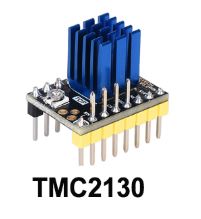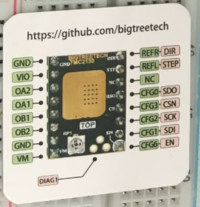TMC2130
| Project TMC2130 | |
|---|---|

| |
| Guide: Connecting TMC2130 and ESP8266 | |
| Status | Completed |
| Contact | Sttc |
| Last Update | 2020-02-16 |
Status
Status as of 2020/1/15:
- Completed
Introduction
TMC2130 is utilized for driving a bi-polar step motor in this example.
TMC2130 is a driver module with many functions. This guide explains how to connect TMC2130 directly with ESP8266 via SPI without a motherboard (e.g. MKS Gen L, RAMPS, Einsy Rambo etc.).
Used components:
- TMC2130
Manufacturer: Big Tree Tech
https://www.aliexpress.com/item/32975341864.html?spm=a2g0s.9042311.0.0.5d3e4c4d6bMkco
https://www.trinamic.com/products/integrated-circuits/details/tmc2130/
https://www.dropbox.com/s/xwongsgvshapqaj/TMC2130-V2.0%20spi%20firmware.docx?spm=a2g0o.detail.1000023.19.4fc612156plDrp&dl=0
https://github.com/bigtreetech/BIGTREETECH-TMC2130-V3.0?spm=a2g0o.detail.1000023.18.4fc612156plDrp&file=BIGTREETECH-TMC2130-V3.0
- ESP8266:
LoLin NodeMCU V3 4MB flash ESP8266 12E
More info on ESP8266: https://randomnerdtutorials.com/esp8266-pinout-reference-gpios/
Wiring
TMC2130 board must be modified for SPI communication mode according to manufacturer's instructions
A capacitor in between Vmotor and GND is recommended (here 220µF was used)

Table: Connecting pins between TMC2130, ESP8266, motor and external power supply
| TMC2130 | ESP8266 | Motor | External power |
|---|---|---|---|
| GND | GND | ||
| VIO | 3V | ||
| OA2 | MOTOR-A2 | ||
| OA1 | MOTOR-A1 | ||
| OB1 | MOTOR-B1 | ||
| OB2 | MOTOR-B2 | ||
| GND | GND | GND | |
| VM | Vmotor (+8V) | ||
| DIR | D2 (GPIO4) | ||
| STEP | D3 (GPIO0) | ||
| NC(not connected) | - | ||
| SD0 | D6 (GPIO12) | ||
| CSN | D8 (GPIO15) | ||
| SCK | D5 (GPIO14) | ||
| SDI | D7 (GPIO13) | ||
| EN | D1 (GPIO5) |
Code
Required libraries:
- TMC2130Stepper
/**
* Author Teemu Mäntykallio
* Modified by Sttc
* Initializes the library and turns the motor in alternating directions.
*/
// ESP8266
#define EN_PIN 5 // D1
#define DIR_PIN 4 // D2
#define STEP_PIN 0 // D3
#define CS_PIN 15 // D8
#define MOSI_PIN 13 // D7
#define MISO_PIN 12 // D6
#define SCK_PIN 14 // D5
bool dir = true;
#include <TMC2130Stepper.h>
TMC2130Stepper driver = TMC2130Stepper(EN_PIN, DIR_PIN, STEP_PIN, CS_PIN, MOSI_PIN, MISO_PIN, SCK_PIN);
void setup() {
Serial.begin(115200);
while(!Serial);
Serial.println("Start...");
driver.begin(); // Initiate pins and registeries
driver.rms_current(600); // Set stepper current to 600mA. The command is the same as command TMC2130.setCurrent(600, 0.11, 0.5);
driver.stealthChop(1); // Enable extremely quiet stepping
driver.microsteps(0);
//Serial.println(driver.microsteps()); // shows microsteps setting
digitalWrite(EN_PIN, LOW);
//Serial.print("DRV_STATUS=0b");
//Serial.println(driver.DRV_STATUS(), BIN);
}
void loop() {
digitalWrite(STEP_PIN, HIGH);
//delayMicroseconds(10);
delay(50);
digitalWrite(STEP_PIN, LOW);
//delayMicroseconds(10);
delay(50);
uint32_t ms = millis();
static uint32_t last_time = 0;
if ((ms - last_time) > 3000) {
if (dir) {
//Serial.println("Dir -> 0");
driver.shaft_dir(0);
} else {
//Serial.println("Dir -> 1");
driver.shaft_dir(1);
}
dir = !dir;
last_time = ms;
}
}
Remarks
- ESP8266 configuration on Arduino IDE:
